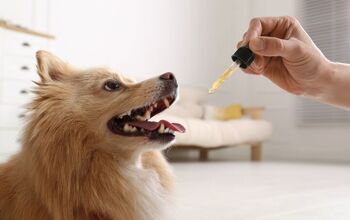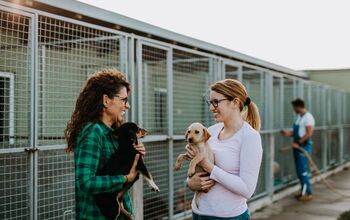Understanding The Dog Heat Cycle

If you have an intact female dog, you should be familiar with the heat cycle so you know what to expect. Like humans, female dogs will start to regularly go through the estrus cycle once they reach puberty – this cycle is typically referred to as “heat” in relation to dogs. We’re going to go over the basics about the dog heat cycle, including its various stages and how to deal with it.
Basics about the Dog Heat Cycle
A female dog will go into heat about twice per year – approximately every six months – starting from the time she reaches puberty. The age at which dogs reach puberty will vary by breed, so consult your veterinarian to know what to expect from your dog in particular. Some small breed dogs may go into heat as often as three times per year while giant breed dogs may only do so every 12 to 18 months. All female dogs, when they first start to go into heat, may have irregular heat cycles until they reach the age of two.
Related: All About Spaying Dogs
The estrus or “heat” cycle of a female dog typically lasts two to three weeks. The cycle begins with the swelling of the external vulva, often accompanied by a vaginal discharge, and ends when the discharge dissipates and the vulva returns to normal size. In many cases, the swelling of the vulva may not be obvious so you should be familiar with some of the other signs of estrus. Within the first few days of the estrus cycle many dogs develop a bloody vaginal discharge. This discharge may change in color and appearance as the dog progresses through her cycle. By 7 to 10 days into the cycle it is usually pink and watery. Other signs of estrus may include the dog urinating more frequently than normal – her urine contains pheromones that become particularly pungent during the estrus cycle so she may mark objects in and around the home as well as outside during walks.
Heat Cycle and Pregnancy
The dog heat cycle is the body’s preparation for conception and pregnancy. For most dogs, ovulation occurs about 7 to 10 days into the cycle when the vaginal discharge becomes pink and watery. This is the period during which the dog will be the most fertile and also the most receptive to breeding. If you do not plan to breed your dog, it is essential that you keep her away from other dogs during this time. Male dogs are able to smell a female in heat and will go to great lengths to get to her. It is not recommended that you leave your female dog outdoors unattended when she is in heat and definitely do not bring her to a dog park or any place where other dogs might be present.
Related: What Dog Breed Is Right For Me?
If a female in heat is mated to an intact male, pregnancy is likely to occur. For dogs, pregnancy lasts for about 63 days (nine weeks) but it is often not possible to detect the pregnancy until about three weeks in. If you suspect that your dog is pregnant, you should have her examined by a veterinarian as soon as possible. An experienced vet will be able palpate the puppies by the 28th to 30th day of pregnancy. Ultrasonic diagnosis of pregnancy can be performed after about 25 days.
If you do not intend to breed your female dog, you may want to have her spayed. It is recommended that you should wait until your female dog is at least 1 year old before this operation is performed. Studies from the Department of Veterinary Clinical Sciences (VCS) at Purdue University suggest you should wait 6 years with larger breeds (Rottweilers, for example). Ask your vet about what option is right for you and your dog and what the correct time to do this is.
Either way, spaying is not an uncommon procedure, and many owners opt for it if they decide that puppies are not an option in the life of their pet. If you are not a licensed breeder, spaying might come as a logical precaution for your pet. In the world of puppers, accidents are quick to happen – leaving your pet unattended for just a few minutes when out walking or in the park, can result in some quick love-making! And the next thing you know, you are left in care of a bunch of delicate little puppies. In such cases, problems quickly mount up and no viable solution appears – people often resort to giving the puppies away, separating the mom from her puppies and vice versa. Not to mention that, with the shelters overflowing with abandoned puppies and dogs seeking a home, bringing more puppies into the world isn’t always the best thing to do.
Is Spaying a Female Dog Dangerous?
Many owners can be frightened merely by the mention of a surgical procedure on their loved pet. However, there’s no room for fear. Spay and neuter procedures are a common practice and most pet owners opt for pet sterilisation, and while it might seem like a huge deal to you- to a medical professional, it is a routine procedure. If you have any uncertainties or worries, a simple talk with your veterinarian can help clear any doubts. They can provide much-needed reassurance and explanation!
Spaying a pet can be a beneficial, reasonable, and responsible decision that can make your pet’s and your own life much easier and simpler. But is the procedure dangerous?
First thing that you need to know is the fact that spaying – when female dogs are considered – is a major surgery that requires a general anesthesia. A vet performs the surgery and has to make an incision in the dog’s abdominal area in order to remove the ovaries and the uterus. But don’t let this scare you: studies show that just 20% of all spaying procedures will show some minor complication. Usually, these are infections due to improper aftercare, bad reactions to general anesthesia, abscesses, broken stitches, and so on. Still, all of these issues are a minor occurrence – less than 5% of all of them are considered serious, and the death rate due to a spaying operation are less than 1% – which should be enough to let you know that it is, in fact, quite safe to perform.

Kate Barrington is the loving owner of two cats (Bagel and Munchkin) and a noisy herd of guinea pigs. Having grown up with golden retrievers, Kate has a great deal of experience with dogs but labels herself a lover of all pets. Having received a Bachelor's degree in English, Kate has combined her love for pets and her passion for writing to create her own freelance writing business, specializing in the pet niche.
More by Kate Barrington























